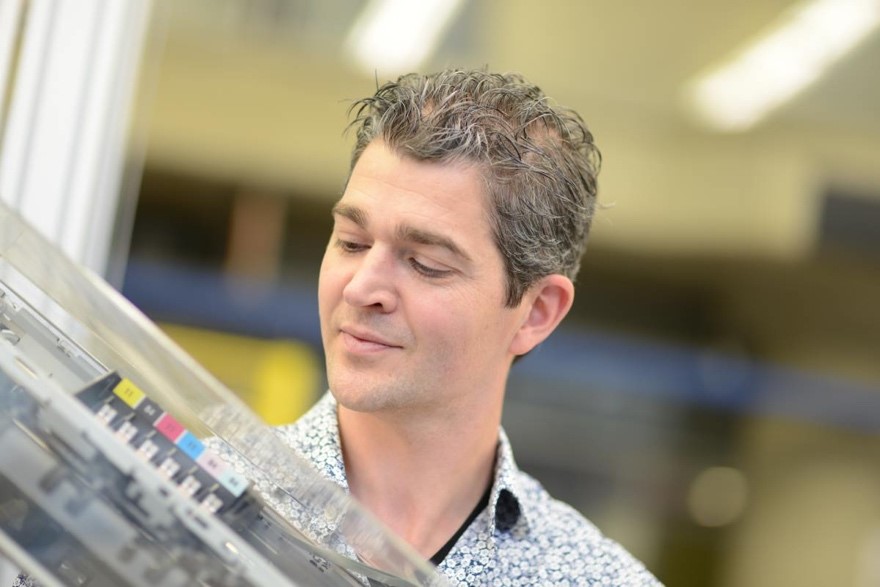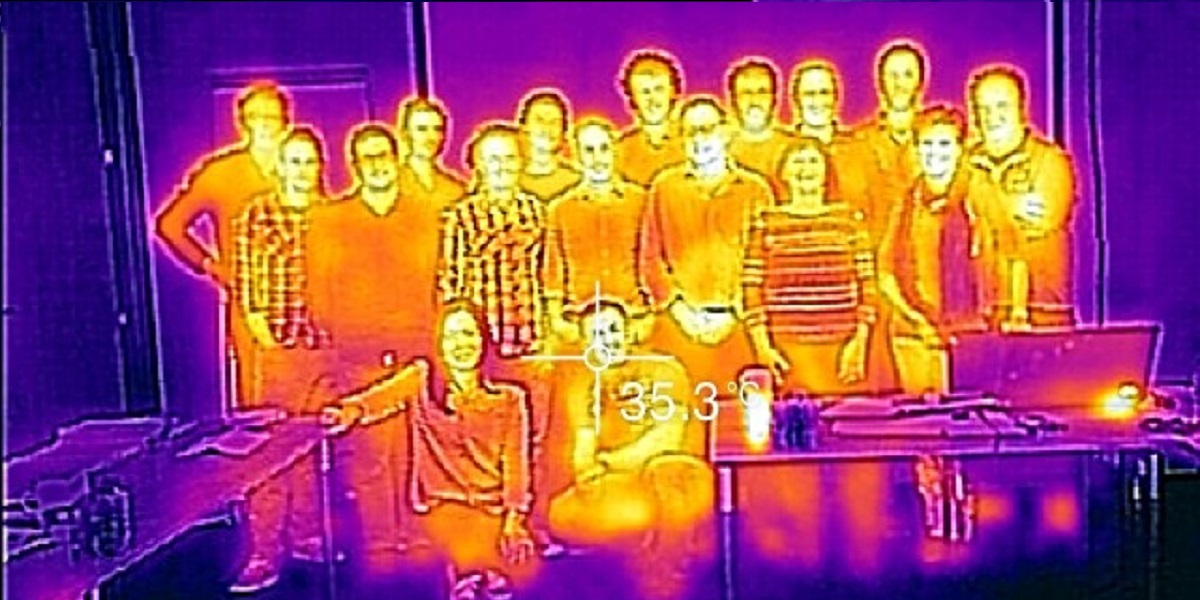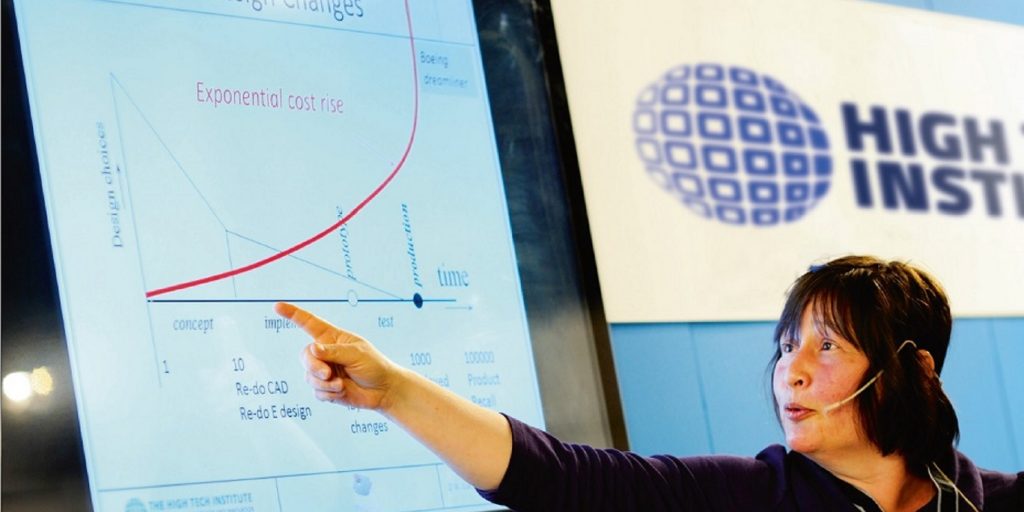Applying iterative learning control can improve the performance of motion systems tremendously. Often, by as much as ten-fold. However, the approach is fundamentally different to that of existing feedback and feedforward techniques. In order for it to be implemented correctly, a thorough understanding of the underlying learning mechanisms is required. The Advanced feedforward & learning control training provides the tools with which control technologists can understand and apply iterative learning control techniques.
.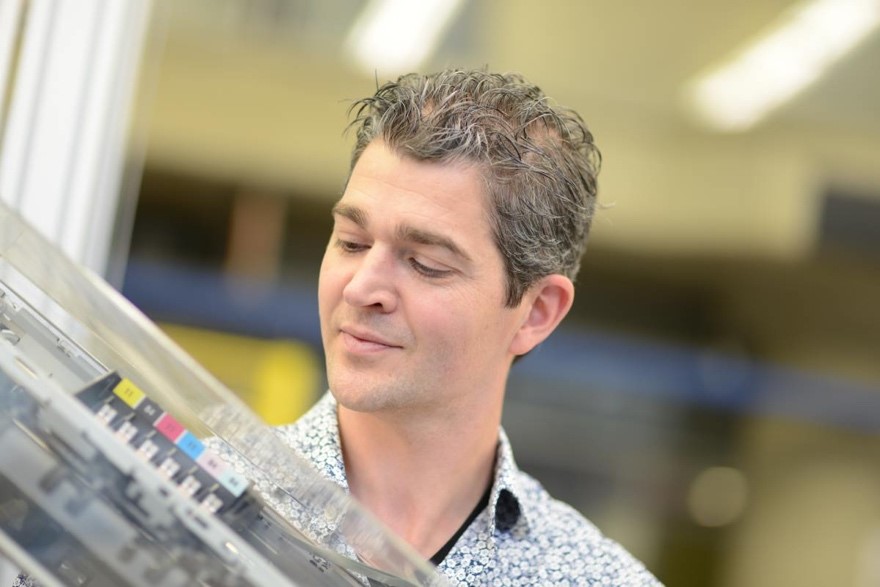
Photo: Tom Oomen, with the steering mechanism of a desktop printer that, despite numerous limitations, has reached an astonishing level of performance due to an iterative learning controller.
Control experts in the industry are also looking at this, says Tom Oomen, from the Control Systems Technology group (TU Eindhoven). He shows us the steering mechanism of a desktop printer that has been converted by a lab assistant into an experimental setup. ‘This is a simple arrangement costing roughly one hundred euros, with a lot of friction and cheap mechanics,’ says Oomen. ‘But despite these limitations, we can still achieve perfect performance with iterative learning control. The measuring accuracy of the printhead is 42 micrometres and with our learning management we stay within that limit.’ He can hardly suppress his enthusiasm: ‘That’s just amazing. Motion control experts also wonder how this can be achieved. Participants in the Advanced feedforward control course will also work with the same printer.’
The Control Systems Technology section, headed by Maarten Steinbuch, at the Technical University of Eindhoven has a long tradition of working with high tech companies. Researchers are working with ASML, CCM, NXP, Océ, Philips Innovation Services and Philips Healthcare on control through iterative learning control. The High Tech Systems Center (HTSC) also plays a role in this. The high tech companies implement and validate the developed algorithms directly on their systems.
Oomen: ‘They all really want to apply iterative learning control, because that’s the way to significantly improve performance. One company wants to achieve nanometer accuracy, the other higher productivity or to employ cheap sensors, actuators or mechanics. Because qua implementation, learning control is very cheap. The solution shifts from expensive measuring instruments and drives to software and smart algorithms. Our starting point is that measurement data are very cheap and that we can full compensate for what is reproducible in the measurement data.’
'The solution shifts from expensive measuring technology and drives to software and smart algorithms.'
Back to basics. Everyone in the control world of the PID-controllers knows about feedback. Feedback generates a correcting action based on a servo error. It is a correction made subsequent to the error. PID controllers are popular because the system is in a ‘closed loop’ and is thus insensitive to changes. Another plus is that developers can work very intuitively with the help of rules of thumb.
The performance of these traditional control systems can be improved considerably by adding feedforward technology. Feedback control is, after all, like shutting the stable door after the horse has bolted: the corrective action follows the error. With the feedforward method the system anticipates future disturbances. If the trajectory is known immediately beforehand, the controller can use this knowledge to significantly reduce the tracking errors. ‘That typically leads to a performance that is ten times better,’ says Tom Oomen. Therefore, it is not surprising that now almost everyone uses feedforward.
But we can top that. By using the repetitive character with which many mechatronic systems work, control systems are able to learn from previous tracking errors. The result is another step forward in performance. Oomen: ‘Compared to traditional combined feedback-feedforward designs, the tracking error can be improved by a factor of ten or more.’ This is the basic idea behind Iterative Learning Control (ILC), with repetitive movements.
Design techniques in the High Tech industry
Learning techniques are central to the three-day Advanced feedforward & learning control training, of which Tom Oomen is one of the trainers and course leaders. ‘On the first day we start with PID controllers and we teach participants why you can only achieve limited performance. Feedforward makes more of a difference, because you give the desired task to your controller and thus look into the future. The idea of learning control is simple: every time you do the same task, you know what will happen in the future. With a good learning control implementation, you can achieve perfect performance. That is also what people in my field say: everything that is reproducible can be perfectly compensated for.’

Photo: Tom Oomen, trainer and course leader of the Advanced feedforward & learning control training course.
Iterative learning control ensures that performance improves step by step. With every experiment, every cycle, the system collects measurement data which is subsequently examined by the learning controller: have I done it better now? If it is perfect, the controller will retain the feedforward control signal. If there is still a fault, a small correction will follow, in order to achieve an even better feedforward control signal. With a good design you see an almost perfect performance after five iterations.’
'With a good design you see an almost perfect performance after five iterations.'
The methods used in the Advanced feedforward & learning control training course fit in very well with the design techniques already known by the Dutch high tech industry. They make it possible to converge motion systems with learning very quickly. Oomen: ‘That is really different to the rest of the world. You see a lot of academic techniques that need hundreds or thousands of iterations in order to converge.’
The unique Eindhoven approach is based on very accurate models for mechatronic systems. Oomen: ‘The basis for this was laid out in the seventies, eighties and nineties at the Philips Natlab, for example in the development of the compact disc players.’ Things that result from this, such as frequency-response-function identification, loop-shaping of PID controllers, and notch-filters, are now to be found in the basic course Motion Control Tuning. Oomen: ‘In the follow-up training, Advanced feedforward control, we construct the learning control technique from the same philosophy from the very beginning, so that from day one, the participants themselves are able to design and implement a learning controller which gives an almost perfect performance after a few iterations.’
Theory
The second day of training contains a lot of theory. The aim is to give participants a complete picture of what is available in the world in the field of learning control. Oomen: ‘Surf the internet for learning control and you will find mountains of information. Many different types of mathematics, usually from a strong academic perspective. Curious technologists automatically ask themselves: Why don’t we apply this?’
There is a world of difference between the alternative mathematical descriptions and the techniques presented to students on the first day. Why then all that hard work? ‘We expressly want students to experience how alternative methods work together in a mathematical way,’ says Oomen. ‘That is indeed quite difficult for most students, because they often have to refresh their underlying mathematical knowledge. Nevertheless, we confront them with it and drag them through the methods consciously, so that they can understand these other approaches and are able to put them into practice.’
Worldwide publications about control techniques always speak of optimal design algorithms. ‘Almost everyone in our profession is working on this,’ says Oomen. ‘That is certainly in line with the criteria they set. We are also going to work on it. Participants in our course experience a lot of parameters that are relevant. Our experience is that understanding all these parameters and how they influence performance is complicated. By letting these participants experience it for themselves, they gain all the knowledge needed to assess what it is that specific algorithms can or cannot do together with their respective advantages and disadvantages. This gives participants the feeling that they can oversee the entire field of iterative learning control. Especially if they want to delve into it more deeply.’
You say that you have to drag participants through the theory and mathematics. Does that always work?
That always works. And once you’ve seen that, you can pretty well see the range of techniques that are available. It is not about reproducing formulas, participants need to know what is behind them, what the basic ideas are and how they can use them. Once they have done this part of the course, the rest is really easy. It’s quite something that they are able to implement Matlab code in two lines. But the most important thing is that participants can substantiate the advantages and disadvantages of specific techniques. It is also nice to have useful knowledge to bring to day three, where we examine recent developments and use automated feedforward tuning.’
How much experience in control technology do participants need to be able to do the Advanced feedforward control training?
‘People with experience in designing controllers and motion systems automatically qualify for this training. This applies to most people who design feedback controllers in the Eindhoven region. They know how to design PID controllers and also what state-space, loop-shaping and filtering techniques are and how to think in the frequency domain. A little Matlab knowledge is also very useful.’
‘The basic knowledge needed is in fact the basic training to be found in the Motion Control Tuning course. The description gives a clear picture of the expected prior knowledge. People may therefore draw the conclusion that they should first follow the Motion Control Tuning training course.’
Can you give some examples of the type of participants in the Advanced feedforward control training sessions?
‘Participants vary from young people who have just left the lecture rooms, to motion control tuning experts who have been working in the industry for twenty years and who design controllers every day. For example, motion control experts from ASML, K&S, Nexperia Itec or Océ who are not yet familiar with iterative learning control. And also, technologists who have already experimented with this new technique in their work and who are interested in it. Among them are many small companies that want to apply iterative learning control. After three days they get a sense of what it can offer for their machine and also, right away, a basic implementation so that they can directly get started on their own machines.’
Before, with regard to the number of iterations, you mentioned five cycles. Does it matter if there are a few more or a few less?
‘The great thing about learning algorithms is that they adapt themselves when the situation changes. If temperature plays a role, for example because of a day-night rhythm, it is nice if the system adjusts within a few iterations. If, for example, 100 iterations, of one hour each, are required, this can lead to production failure.’
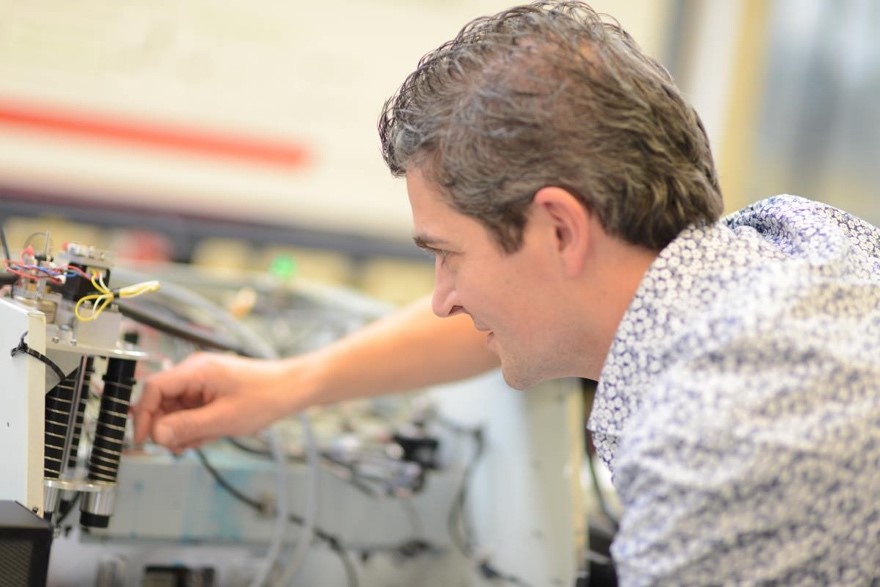
Oomen gives another extreme example. In collaboration with the researchers from the Eindhoven research institute Differ, the motion control group applied learning techniques to nuclear fusion experiments for the Tokamak reactor (TCV) in Lausanne. ‘Physicists have traditionally relied on complex physical models to simulate these fusion processes. There is a big gap between the use of data and control technology. My colleague Federico Felici has expertise in nuclear fusion, in addition to a background in iterative learning control technology. He is now dabbling in that world from his technical background.’
In Tokamak reactor experiments it comes down to plasma formation by means of the correct actuator signals. Such a shot takes a few seconds and is very expensive. ‘Because a complex computer simulator had already been developed, we were able to calculate how to adjust the signal to make it better. To do this, we linked the simulator to the measurement data from the experiments. It turned out that with our iterative learning control technology we had an almost perfect control signal within a number of iterations. That has had a lot of impact in the nuclear fusion world.’
This article is written by René Raaijmakers, tech editor of Bits&Chips.
Recommendation by former participants
By the end of the training participants are asked to fill out an evaluation form. To the question: 'Would you recommend this training to others?' they responded with a 9 out of 10.
